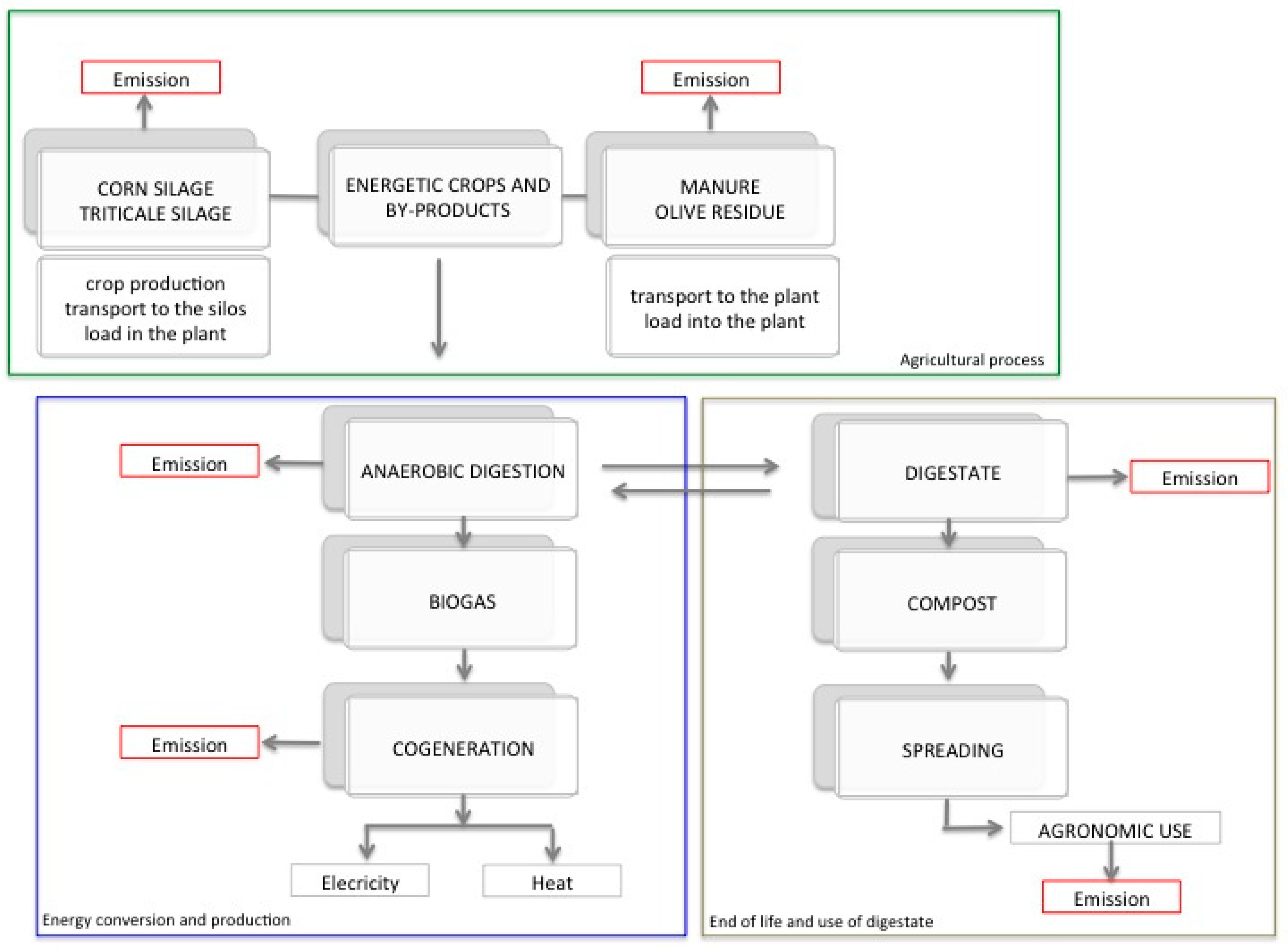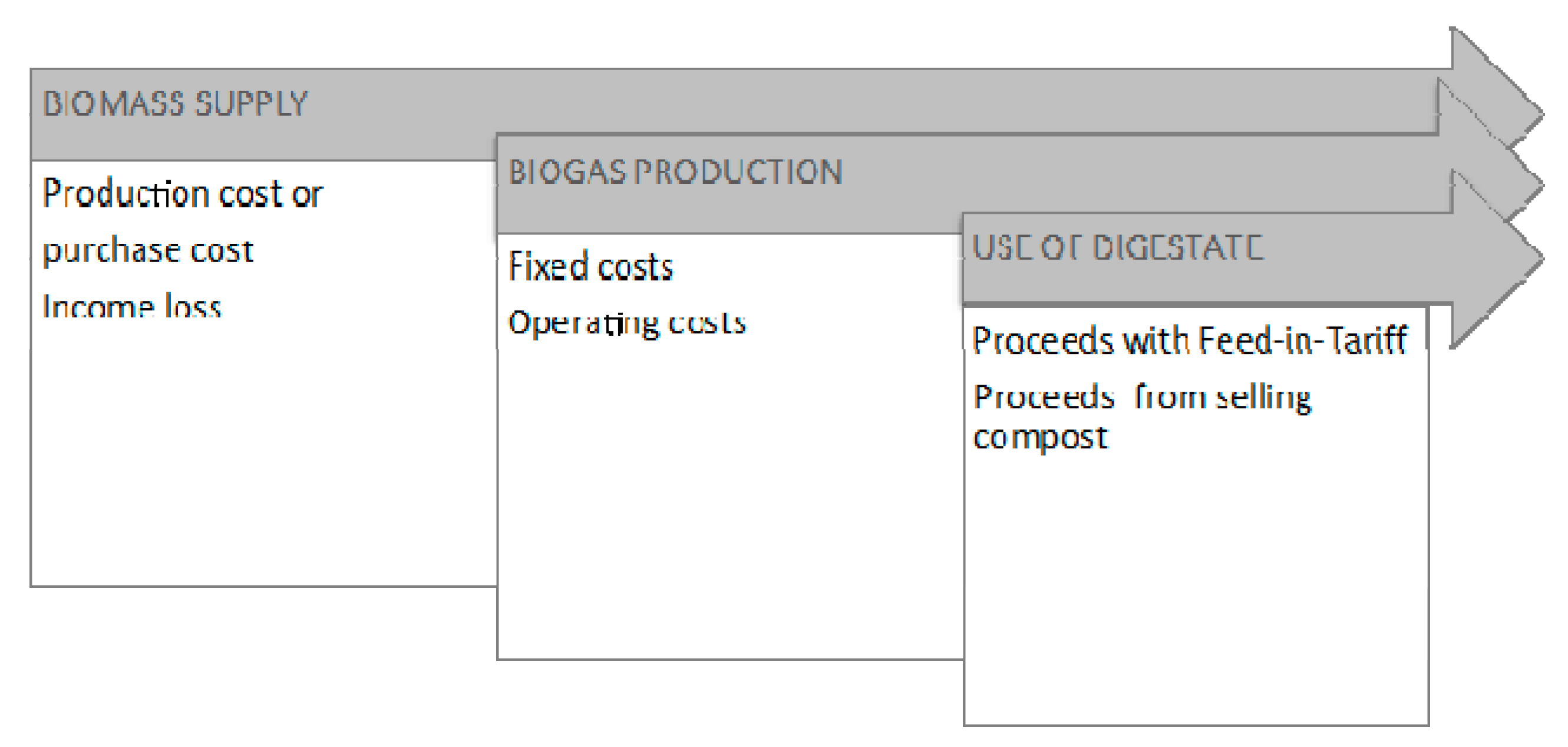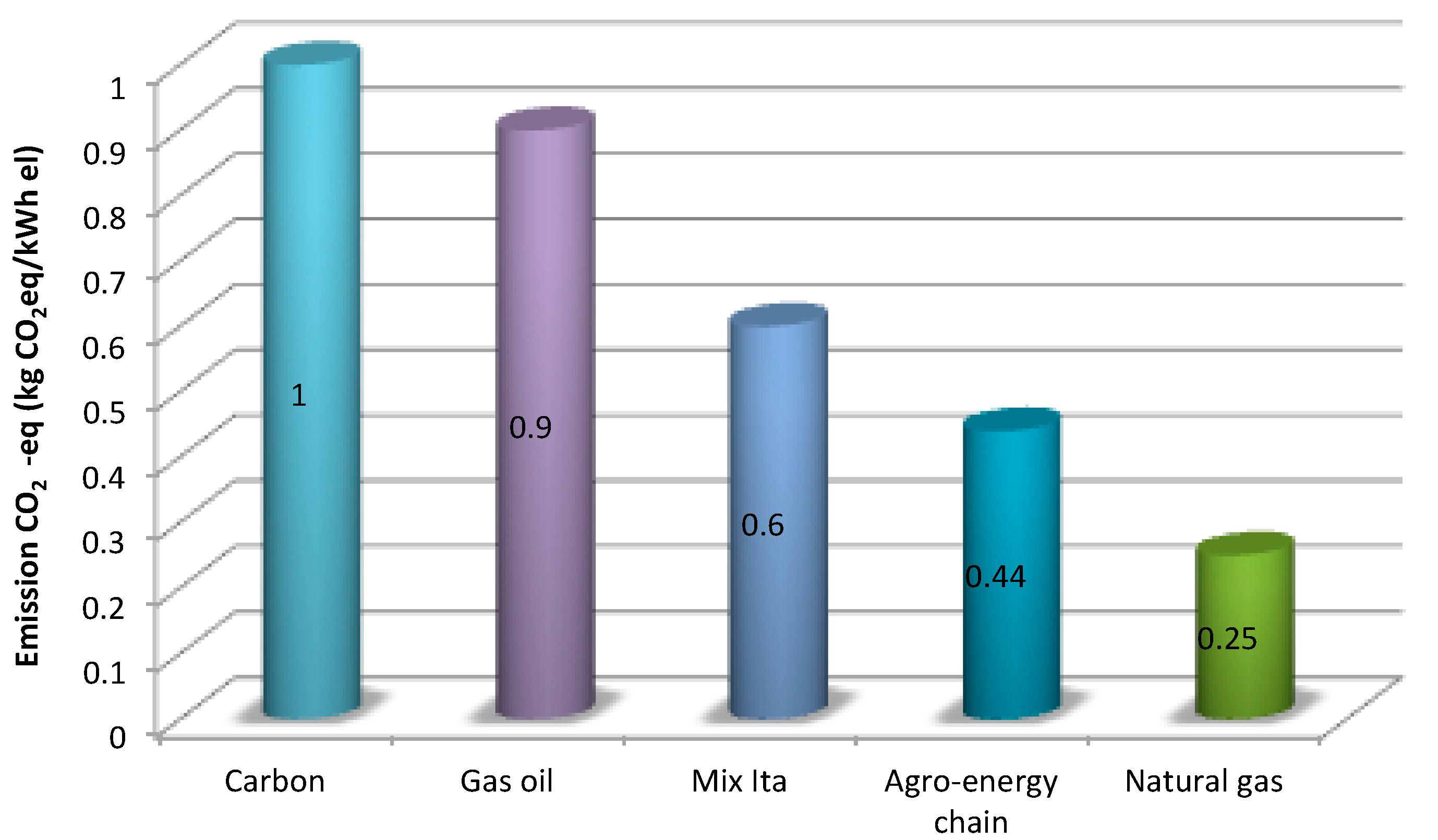Environmental Sustainability and Economic Benefits of Dairy Farm Biogas Energy Production: A Case Study in Umbria
Abstract
:1. Introduction
Life Cycle Assessment (LCA) Applied to Biogas Plants
2. Method and Data
2.1. Goal and Scope of the Research
2.1.1. Description and Characteristics of the Biogas Plant and Dairy Farm
| Biomass | Quantity (t) | Source |
|---|---|---|
| Cow sewage | 8600 | From farm |
| Cow manure | 1200 | From farm |
| Corn silage | 5530 | From farm |
| Triticale silage | 1500 | From farm |
| Corn silage | 2370 | From other providers |
| Olive Residues | 200 | From other providers |
| Total | 19,400 |
2.1.2. Functional Unit and Allocation
2.1.3. System Boundaries
- (1)
- Agricultural process: (i) production processes for corn and triticale silage; (ii) manure handling systems; (iii) transport of corn silage and solid olive residues from sources outside the farm; (iv) feeding materials into the digester;
- (2)
- Energy conversion: (i) anaerobic digestion (AD); (ii) biogas production; (iii) co-generation (production of electricity and heat);
- (3)
- End-of-life of digestate: (i) storage; (ii) spreading; (iii) agronomic use.

2.2. Life Cycle Inventory
| Crops and By-Products | Operation | Machinery | Operating Rate (h ha−1) | Diesel Consumption (kg ha−1) | Diesel Consumption (kg km−1) | Diesel Consumption (kg h−1) | Material (kg ha−1) | Water Consumption (mc ha−1) | Water Pump Consumption (kW h ha−1) |
|---|---|---|---|---|---|---|---|---|---|
| Maize silage | Ploughing | Tractor (157 kW) + ploughshare | 4.5 | 16.6 | |||||
| Harrowing | Tractor (157 kW) + disc harrow | 1.5 | 14.94 | ||||||
| Dressing | Tractor (60 kW) + fertilizer spreader | 1 | 4.98 | Ammonium phosphate | 200 | ||||
| Sulfate ammonium | 400 | ||||||||
| Dressing | Tractor (60 kW) + tank | 3 | 5.5 | Cow sewage | 9000 | ||||
| Tractor (60 kW) + manure spreader | 3 | 4.46 | Cow manure | 6500 | |||||
| Sowing | Tractor (60 kW) + sower | 1 | 8.3 | Seeds | 24 | ||||
| Weed control | Tractor (60 kW) + field sprayer | 1 | 8.3 | Pendimethalin | 3 | ||||
| Crop protection | Tractor (60 kW) + field sprayer | Combine with sowing | Combine with sowing | Pyrethroids | 8 | ||||
| Sprinkler irrigation | 1000 | ||||||||
| Harvesting | Combine harvester | 1.5 | 41.5 | ||||||
| Transport to the silos | Tractor (60 kW) + tractor trailer | 0.23 | |||||||
| Feeding material into the digester | Telescopic handler | ||||||||
| Triticale silage | Ploughing | Tractor (157 kW) + ploughshare | 3 | 14.94 | |||||
| Harrowing | Tractor (157 kW) + disc harrow | 1 | 12.45 | ||||||
| Sowing | Tractor (60 kW) + sower | 1 | 8.3 | Seeds | 200 | ||||
| Harvesting | Combine harvester | 1 | 41.5 | ||||||
| Transport to the silos | Tractor (60 kW) + tractor trailer | 0.25 | |||||||
| Feeding material into the digester | Telescopic handler | ||||||||
| Cow manure | Transport to the plant | Tractor (60 kW) + tractor trailer | 0.25 | ||||||
| Feeding material into the digester | Front loader | ||||||||
| Olive residues | Transport to the plant | Tank truck | 0.33 | ||||||
| Feeding material into the digester | Front loader | ||||||||
| 2.49 |
2.2.1. Agricultural Process
2.2.2. Energy Production
2.2.3. End-of-Life of the Digestate
2.3. Economic Analysis

3. Results
3.1. Environmental Impact of the Agro-Energetic Chain
| Processes | Stage of agro— energy chain | CO2 Emissions (kg) | N2O Emissions in CO2 eq (kg) | CH4 Emissions in CO2 eq (kg) | CO2 eq (kg) Total emissions |
|---|---|---|---|---|---|
| Biomass supply | Corn silage from the farm | 193,000 | 521,250 | 714,250 | |
| Corn silage from other providers | 141,000 | 380,800 | 521,800 | ||
| Triticale silage | 3640 | 9830 | 13,470 | ||
| Manure | 5940 | 5940 | |||
| Olive residues | 1630 | 1630 | |||
| Biogas Production | Loading materials into the plants | 8940 | 8940 | ||
| Anaerobic digestion (*) | - | 578,250 | 578,250 | ||
| Use of digestate | Composting | 34,200 | 34,200 | ||
| Spreading digestate (**) | - | 64,250 | 64,250 | ||
| Total | 304,810 | 911,880 | 642,500 | 1,859,380 | |

3.2. Economic Sustainability
| Processes | Stage of agro-energy chain | Production costs or purchase costs | Income loss | Fixed costs | Operating costs | Revenue with feed-in tariff |
|---|---|---|---|---|---|---|
| Cost analysis | ||||||
| Biomass supply | Corn silage | 153,990 | 66,360 | |||
| Corn silage, outside providers | 94,800 | |||||
| Triticale silage | 41,770 | 18,000 | ||||
| Manure | 16,800 | |||||
| Olive residues | 2000 | |||||
| Biogas production | Loading materials into the plants | 12,400 | ||||
| Anaerobic digestion | 152,500 | 350,000 | ||||
| Digestate production | Composting | 47,500 | 4000 | |||
| Spreading digestate | ||||||
| Revenue analysis | ||||||
| Energy production | Production of electricity fed into the grid | 1,058,680 | ||||
| Digestate production | Digestate production | 42,000 | ||||
| Total costs | 295,560 | 101,160 | 200,000 | 366,400 | ||
| Total revenues | 1,100,680 | |||||
| Biogas plant/digestate/composting | Euro |
|---|---|
| Planning and authorization | 50,000 |
| Biogas plant | 1,950,000 |
| Hydraulic and electrical system | 120,000 |
| Civil works | 80,000 |
| Construction of access road | 5000 |
| Contingence (10% cost of the plant) | 195,000 |
| Composting plant | 600,000 |
| Total | 3,000,000 |
4. Discussions and Recommendations
Acknowledgments
Author Contributions
Conflicts of Interest and Notes
References and Notes
- Pellerano, A.; Pantaleo, A.; Tenerelli, P.; Carone, M.T. Studio Per La Valorizzazione Energetica Di Biomasse Agro Forestali Nelle Regione Puglia; Dipartimento PROGESA, Università di Bari: Bari, Italy, 2007. (In Italian) [Google Scholar]
- Cherubini, F.; Strømman, A.H. Life cycle assessment of bioenergy systems: State of the art and future challenges. Bioresour. Technol. 2011, 102, 437–451. [Google Scholar] [CrossRef]
- Piccinini, S.; Vismara, S. Il biogas nel piano di azione nazionale per le energie rinnovabili e il parco impianti in Europa e in Italia. In Biogas Da Agrozootecnia E Agroindustria; Vismara, R., Canziani, R., Malpei, F., Piccinini, S., Eds.; Dario Flaccovio Editore: Palermo, Italy, 2011; pp. 1–17. (In Italian) [Google Scholar]
- Holm-Nielsen, J.B.; Al Seadi, T.; Oleskowicz-Popiel, P. The future of anaerobic digestion and biogas utilization. Bioresour. Technol. 2009, 100, 5478–5484. [Google Scholar] [CrossRef]
- Iglinski, B.; Buczkowski, R.; Iglinska, A.; Cichosz, M.; Piechota, G.; Kujawski, W. Agricultural biogas plants in Poland: Investment process, economical and environmental aspects, biogas potential. Renew. Sustain. Energy Rev. 2012, 16, 4890–4900. [Google Scholar] [CrossRef]
- Frascarelli, A. Le energie rinnovabili in agricoltura. Agriregionieuropa anno. 2011, 7. No. 24. Available online: http://agriregionieuropa.univpm.it/content/article/31/24/le-energie-rinnovabili- agricoltura (accessed on 11 September 2014). (In Italian)
- Berglund, M.; Borjesson, P. Assessment of Energy performance in the life-cycle of biogas production. Biomass Bioenergy 2006, 30, 254–266. [Google Scholar] [CrossRef]
- Kimming, M.; Sundberg, C.; Nordberg, A.; Baky, A.; Bernesson, S.; Nore, O.; Hansson, P.A. Biomass from agriculture in small-scale combined heat and power plants e A comparative life cycle assessment. Biomass Bioenergy 2011, 35, 1572–1581. [Google Scholar] [CrossRef]
- Chiodo, E.; Nardella, N. Valorizzazione energetica di residui e sottoprodotti della filiera vitivinicola in Italia. Agriregionieuropa anno. 2011, 7, pp. 22–25. Available online: http://agriregionieuropa.univpm.it/content/article/31/24/valorizzazione-energetica-di-residui-e-sottoprodotti-della-filiera (accessed on 11 September). (In Italian)
- CRPA Project: Sustainable and Innovative European Biogas Environment (SEBE), 2011
- Pöschl, M.; Ward, S.; Owende, P. Evaluation of energy efficiency of various biogas production and utilization pathways. Appl. Energy J. 2010, 87, 3305–3321. [Google Scholar] [CrossRef]
- Institute for Energy and Environment-IEE. Ecological analysis of biogas utilization from renewable resources, Leipzig (Germany): Institute for Energy and Environment, by order of Agency for Renewable Resources, 2006
- Jury, C.; Benetto, E.; Koster, D.; Schmitt, B.; Welfring, J. Life cycle assessment of biogas production by monofermentation of energy crops and injection into the natural gas grid. Biomass Bioenergy 2009, 34, 54–66. [Google Scholar] [CrossRef]
- Cherubini, F. GHG balances of bioenergy systems–overview of key steps in the production chain and methodological concerns. Renew. Energy 2010, 35, 1565–1573. [Google Scholar] [CrossRef]
- Petrou, E.C.; Pappis, C.P. Biofuels: A survey on pros and cons. Energy Fuels 2009, 23, 1055–1066. [Google Scholar] [CrossRef]
- Sheehan, J.J. Biofuels and the conundrum of sustainability. Curr. Opin. Biotechnol. 2009, 20, 318–324. [Google Scholar] [CrossRef]
- Blengini, G.A.; Brizioc, E.; Cibrario, M.; Genon, G. LCA of bioenergy chains in Piedmont (Italy): A case study to support public decision makers towards sustainability. Resour. Conserv. Recycl. 2011, 57, 36–47. [Google Scholar] [CrossRef]
- Muench, S.; Guenther, E. A systematic review of bioenergy life cycle assessments. Appl. Energy 2013, 112, 257–273. [Google Scholar] [CrossRef]
- Battini, F.; Agostini, A.; Boulamnati, A.K.; Giuntoli, J.; Amaducci, S. Mitigating the environmental impacts of milk production via anaerobic digestion of manure: Case study of a dairy farm in the Po Valley. Sci. Total Environ. 2014, 481, 196–208. [Google Scholar] [CrossRef]
- Pöschl, M.; Ward, S.; Owende, P. Environmental impacts of biogas deployment—Part I: Life cycle inventory for evaluation of production process emissions to air. J. Clean. Prod. 2012, 24, 168–183. [Google Scholar] [CrossRef]
- Pöschl, M.; Ward, S.; Owende, P. Environmental impacts of biogas deployment—Part II: Life cycle assessment of multiple production and utilization pathways. J. Clean. Prod. 2012, 24, 184–201. [Google Scholar] [CrossRef]
- International Organization for Standardization (ISO). Environmental Management–Life Cycle Assessment–Principles and Framework; ISO 14040:2006; ISO: Geneva, Switzerland, 2006. [Google Scholar]
- Institute for Environment and Sustainability IES (IES). International Reference Life Cycle Data System (ILCD) Handbook–General guide for Life Cycle Assessment–Detailed Guidance; Publications Office of the European Union: Luxemburg, Luxemburg, 2010. [Google Scholar]
- Society of Environmental Toxicology and Chemisty (SETAC). Guidelines for Life-Cycle Assessment: A Code of Practice; SETAC: Brussels, Belgium, 1993. [Google Scholar]
- United Nations Environment ProgrammeUNEP. Life Cycle Management: How business uses it to decrease footprint, create opportunities and make value chains more sustainable. Available online: http://www.unep.fr/shared/publications/pdf/DTIx1208xPA-LifeCycleApproach-Howbusinessusesit.pdf (accessed on 11 September 2014).
- International Organization for Standardization (ISO). Environmental Management–Life Cycle Assessment–Requirements and Guidelines; ISO 14044:2006; ISO: Geneva, Switzerland, 2006. [Google Scholar]
- SimaPro Software and Sustainability Consulting. Available online: http://www.pre.nl/ (accessed on 11 September 2014).
- Decreto Ministeriale del 6 luglio 2012—Nuovo sistema di incentivi per la produzione di energia da fonti rinnovabili elettriche non fotovoltaiche. Available online: http://www.sviluppoeconomico.gov.it/images/stories/normativa/DM_6_luglio_2012_sf.pdf (accessed on 11 September 2014). (In Italian)
© 2014 by the authors; licensee MDPI, Basel, Switzerland. This article is an open access article distributed under the terms and conditions of the Creative Commons Attribution license (http://creativecommons.org/licenses/by/4.0/).
Share and Cite
Torquati, B.; Venanzi, S.; Ciani, A.; Diotallevi, F.; Tamburi, V. Environmental Sustainability and Economic Benefits of Dairy Farm Biogas Energy Production: A Case Study in Umbria. Sustainability 2014, 6, 6696-6713. https://doi.org/10.3390/su6106696
Torquati B, Venanzi S, Ciani A, Diotallevi F, Tamburi V. Environmental Sustainability and Economic Benefits of Dairy Farm Biogas Energy Production: A Case Study in Umbria. Sustainability. 2014; 6(10):6696-6713. https://doi.org/10.3390/su6106696
Chicago/Turabian StyleTorquati, Biancamaria, Sonia Venanzi, Adriano Ciani, Francesco Diotallevi, and Vincenzo Tamburi. 2014. "Environmental Sustainability and Economic Benefits of Dairy Farm Biogas Energy Production: A Case Study in Umbria" Sustainability 6, no. 10: 6696-6713. https://doi.org/10.3390/su6106696




